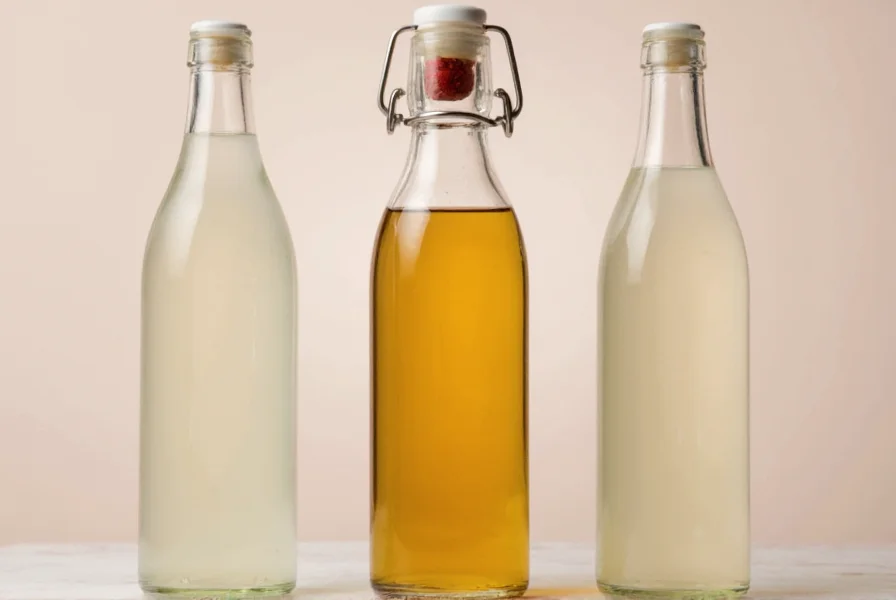White vinegar and distilled vinegar are the same product—there's no difference between them. If you've ever wondered if these two bottles in your pantry are distinct, you're not alone. Many people assume they're different, but in reality, they refer to identical vinegar made from distilled grain alcohol.
Table of Contents
- Vinegars Demystified: What's the Truth?
- Why This Matters in Cooking & Cleaning
- Smart Storage Tips for Vinegar
- Spice Hacks Using White/Distilled Vinegar
- Frequently Asked Questions
- Buying Guide: Which One Should You Choose?
- Conclusion: No Difference, Just Labeling
Vinegars Demystified: What's the Truth?
White vinegar and distilled vinegar are interchangeable terms for the same product. The confusion arises from inconsistent labeling practices, but chemically and functionally, they are identical. Here's a clear breakdown:
| Type | Main Ingredient | Acidity Level | Best For |
|---|---|---|---|
| White Vinegar (Distilled Vinegar) | Distilled grain alcohol | 5–8% | Cleaning, pickling, baking |
| Apple Cider Vinegar | Apple cider fermented into vinegar | 5–6% | Health tonics, marinades, salad dressings |
| Balsamic Vinegar | Grape must, aged in wood barrels | 6% | Salad dressings, reductions, drizzling |
Key clarification: All "white vinegar" is distilled vinegar, and all "distilled vinegar" is white vinegar. The terms are used interchangeably in grocery stores worldwide. Any perceived differences are due to brand-specific variations in acidity or additives, not the vinegar type itself.
Why This Matters in Cooking & Cleaning
Since white vinegar and distilled vinegar are the same product, there are no inherent differences between them. However, brand-specific factors may affect usage:
- Acidity Variations: Some brands may have slightly higher acidity (up to 8%) for industrial cleaning, while others stay at 5% for culinary use. Always check the label.
- Culinary Use: For most recipes, any brand of white/distilled vinegar works perfectly. The neutral flavor makes it ideal for pickling, baking, and balancing spices.
- Cleaning: Higher-acidity versions (6-8%) are better for tough jobs like removing limescale, but standard 5% works for everyday cleaning.
Smart Storage Tips for Vinegar
White/distilled vinegar has an indefinite shelf life when stored properly:
- Keep It Cool & Dark: Store in a pantry away from sunlight and heat sources.
- Airtight Seals: Ensure caps are tightly sealed to prevent evaporation.
- Glass Containers: Use glass bottles instead of plastic for long-term storage to avoid chemical leaching.
- No Refrigeration Needed: Unlike other vinegars, white/distilled vinegar doesn't require refrigeration.
| Type | Shelf Life | Storage Tip |
|---|---|---|
| White/Distilled Vinegar | Indefinite | Store in original bottle away from light |
| Apple Cider Vinegar | Up to 5 years | Check for cloudiness before use |
| Balsamic Vinegar | Up to 10 years | Sealed tightly to avoid oxidation |
Spice Hacks Using White/Distilled Vinegar
Since white and distilled vinegar are identical, these hacks work with any brand:
1. Infused Chili Vinegar
Ingredients: Dried red chilies, garlic, white/distilled vinegar, sugar (optional)
Instructions: Simmer chilies and garlic in vinegar for 10 minutes. Let cool and store in a sealed jar. Use within 3 months for best flavor.
2. Garlic-Vinegar Rub for Smoky Meats
Mix crushed garlic with white/distilled vinegar, paprika, salt, and pepper. Rub onto ribs or chicken before smoking for a tangy kick.
3. Quick Pickled Jalapeños
Bring white/distilled vinegar, water, and sugar to a boil. Pour over sliced jalapeños in a jar and let sit for 24 hours. Perfect for tacos and nachos!
Frequently Asked Questions
Are white vinegar and distilled vinegar the same thing?
Yes, they are identical. "White vinegar" and "distilled vinegar" are two names for the same product made from distilled grain alcohol. The confusion comes from inconsistent labeling practices, but chemically and functionally, there's no difference.
Can I use white vinegar instead of distilled vinegar in recipes?
Absolutely. Since they're the same product, you can substitute one for the other without any issues. The only exception would be if a recipe specifies a particular brand's acidity level (e.g., "8% for pickling"), but this refers to the brand, not the vinegar type.
Why do some recipes specify "distilled vinegar" while others say "white vinegar"?
This is purely a labeling preference. In the U.S., "white vinegar" is more common for culinary use, while "distilled vinegar" is often used for cleaning products. However, the product inside is identical—just different marketing terms for the same vinegar.
Buying Guide: Which One Should You Choose?
When shopping, ignore the "white" vs. "distilled" labels—they're the same product. Focus on these factors:
Top Picks for Vinegar Brands
| Product | Features | Best For | Target Audience |
|---|---|---|---|
| Heinz Distilled White Vinegar | Pure, clear, 5% acidity, USDA-certified | Pickling, cooking, household uses | Home cooks, beginner chefs |
| Cumberland Falls Distilled Vinegar | Smooth, neutral taste; 5% acidity | Marinades, sauces, spice infusions | |
| Nature's Way Organic Apple Cider Vinegar | Raw, unpasteurized, with "mother" culture | Health shots, herbal tinctures, salad dressings | Wellness-focused users |
| Colavita Balsamic Vinegar of Modena | Aged, sweet, complex flavor | Drizzling, reductions, gourmet dishes | Fine dining enthusiasts |

How to Choose Based on Your Needs
- For Everyday Cooking: Choose any brand labeled "white vinegar" or "distilled vinegar"—they're identical. Heinz is a reliable choice.
- For Cleaning: Look for higher acidity (6-8%) versions, often sold as "cleaning vinegar" but still technically white/distilled vinegar.
- For Health & Wellness: Apple cider vinegar is popular for detox drinks and gut health.
- For Gourmet Touch: Splurge on aged balsamic for salads and desserts.
Conclusion: No Difference, Just Labeling
White vinegar and distilled vinegar are the same product—period. The confusion stems from inconsistent labeling practices, not actual differences. Next time you're shopping, ignore the "white" vs. "distilled" labels and focus on acidity levels and brand quality instead.
Happy seasoning, vinegar fans!










 浙公网安备
33010002000092号
浙公网安备
33010002000092号 浙B2-20120091-4
浙B2-20120091-4